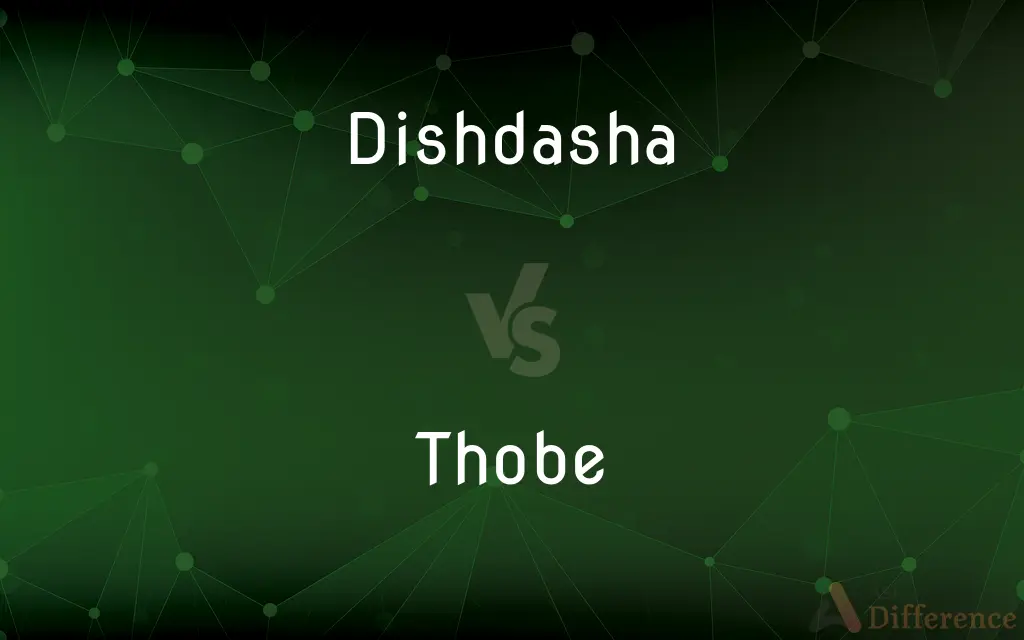Dishdasha vs. Thobe — What's the Difference?
By Tayyaba Rehman & Urooj Arif — Updated on April 9, 2024
The Dishdasha is a traditional ankle-length garment worn by men in the Arabian Peninsula, characterized by long sleeves and a tassel, while a Thobe is a term more widely used across the Arab world for similar garments, without specific regional features.

Difference Between Dishdasha and Thobe
Table of Contents
ADVERTISEMENT
Key Differences
The Dishdasha and Thobe are both traditional garments worn in the Arab world, serving not only as cultural attire but also as a reflection of regional identity and climate-adapted clothing. The Dishdasha, predominantly worn in countries like Oman and Kuwait, is known for its loose fit, which aids in air circulation, keeping the wearer cool in the desert heat, whereas the Thobe, with its broader geographic usage, including countries like Saudi Arabia and Qatar, might have slight variations in style such as the presence or absence of a collar, subtle differences in sleeve design, or the use of different fabrics to suit local preferences and weather conditions.
Both garments are typically made from cotton or wool, making them suitable for the hot climate of the Middle East. The Dishdasha often features a tassel (tarboosh) on the neck, which serves both decorative and functional purposes, like absorbing sweat, while Thobes might not always have this feature, depending on the region and the specific style.
Culturally, these garments are a symbol of identity and tradition. The Dishdasha, for instance, is often white or beige, colors that reflect the sun's rays and are preferred in the Gulf region for their heat-reflective properties. Thobes, on the other hand, while also favoring lighter shades, can be found in a wider range of colors and patterns, especially in countries like Jordan or Syria, where the garment is called by different names such as "Kandura" or "Jalabiya" in some regions, indicating a broader acceptance of diverse styles.
In formal settings, both the Dishdasha and Thobe are worn with pride and dignity, often complemented with a shemagh or ghutra (headscarf) and iqal (a cord used to secure the headscarf), showcasing the richness of Arab culture. However, the Dishdasha might be more specifically tailored with ceremonial adornments in certain countries, while the Thobe could be kept simpler for everyday wear.
The choice between a Dishdasha and a Thobe may also reflect personal or regional identity, with individuals opting for the style that best represents their heritage. While in Oman, the Dishdasha is a clear marker of national identity, in the broader Arab world, the term Thobe is used more generically to describe similar garments, highlighting the unity and diversity within Arab cultures.
ADVERTISEMENT
Comparison Chart
Regional Usage
Predominantly in Oman and Kuwait
Used broadly across the Arab world
Key Features
Often has a tassel (tarboosh)
Style and features can vary; may or may not have a tarboosh
Material
Usually made of cotton or wool
Primarily cotton, wool, or synthetic blends for modern variations
Cultural Significance
Symbolizes national identity in specific regions
Represents Arab identity more broadly, with regional variations
Variations
Less variation in style within regions it is worn
More variations in style, fabric, and color across different regions
Compare with Definitions
Dishdasha
Characterized by a tassel hanging from the neckline.
The tassel on his dishdasha swayed gently with every step.
Thobe
Available in various fabrics and colors.
His winter thobe was made of heavier, darker fabric.
Dishdasha
A traditional Arabian garment, long and loose-fitting.
He wore an immaculate white dishdasha to the gathering.
Thobe
Often accessorized with a shemagh or ghutra.
He paired his thobe with a red and white ghutra.
Dishdasha
Reflects the wearer's status and region.
His luxurious dishdasha indicated his high social standing.
Thobe
May include decorative elements for formal occasions.
The embroidered thobe stood out at the wedding.
Dishdasha
Made from light materials for desert climates.
His dishdasha, made of fine cotton, was perfect for the hot day.
Thobe
Worn broadly across the Arab world.
Visitors noted the variety of thobes at the market.
Dishdasha
Commonly worn with a keffiyeh in countries like Oman.
Along with his dishdasha, he donned a matching keffiyeh.
Thobe
A traditional Arab garment, similar to a robe.
For the Eid celebration, he chose a silk thobe.
Dishdasha
A long robe with long sleeves, worn by men from the Arabian peninsula.
Thobe
An ankle-length, long-sleeved, gownlike garment worn chiefly by men of the Arabian Peninsula.
Dishdasha
A loose, long-sleeved garment; a thobe.
Thobe
A similar, often embroidered women's garment, usually worn for formal occasions.
Dishdasha
An ankle-length robe with long sleeves worn by some Arab men.
Thobe
An ankle-length robe with long sleeves, worn by some Arab men and traditionally by Palestinian women.
Common Curiosities
What is a Thobe?
A term used across the Arab world to describe a similar traditional garment, with regional variations in style and material.
Are Dishdashas only white?
They are primarily white or beige to reflect the sun, but variations exist depending on the region and occasion.
Can Thobes be worn for formal occasions?
Yes, Thobes designed for formal occasions may feature intricate designs and be made from luxurious fabrics.
Is there a difference in the way Dishdashas and Thobes are worn?
The basic style of wearing them is similar, but regional variations and personal preferences can influence specific styles and accessories.
Are there color restrictions for Thobes?
While lighter colors are common, particularly in hotter climates, Thobes are available in a wide range of colors, especially for special occasions.
What is a Dishdasha?
A traditional, long, and loose garment worn by men in the Arabian Peninsula, known for its simplicity and comfort.
How do the materials of Dishdashas and Thobes differ?
Dishdashas are usually made from lightweight materials for desert climates, while Thobes can vary from light to more luxurious fabrics.
Can the design of a Thobe indicate the wearer's nationality?
Yes, certain design elements and ways of wearing Thobes can indicate the wearer's country of origin within the Arab world.
Do Dishdashas and Thobes always come with a tassel?
Dishdashas often feature a tassel, while Thobes may or may not have one, depending on the specific design.
How are Dishdashas and Thobes accessorized?
Both can be paired with traditional headgear like the keffiyeh, shemagh, or ghutra, though the style may vary by region.
What occasions are Dishdashas worn for?
Dishdashas can be worn for both daily activities and formal occasions, depending on the material and design.
Are Dishdashas considered formal wear?
In many regions, a well-made Dishdasha is suitable for formal occasions, especially when made from finer materials.
Can women wear Thobes?
The term "Thobe" specifically refers to men's attire, but similar garments for women exist with different names.
Is there a difference in maintenance between Dishdashas and Thobes?
Maintenance can vary depending on the fabric and design complexity, with more luxurious or intricately designed garments requiring more care.
How do climate and geography influence the choice between a Dishdasha and a Thobe?
The choice is often influenced by the local climate, with lighter materials preferred in hotter regions.
Share Your Discovery

Previous Comparison
Kipskin vs. Calfskin
Next Comparison
Education vs. EdificationAuthor Spotlight
Written by
Tayyaba RehmanTayyaba Rehman is a distinguished writer, currently serving as a primary contributor to askdifference.com. As a researcher in semantics and etymology, Tayyaba's passion for the complexity of languages and their distinctions has found a perfect home on the platform. Tayyaba delves into the intricacies of language, distinguishing between commonly confused words and phrases, thereby providing clarity for readers worldwide.
Co-written by
Urooj ArifUrooj is a skilled content writer at Ask Difference, known for her exceptional ability to simplify complex topics into engaging and informative content. With a passion for research and a flair for clear, concise writing, she consistently delivers articles that resonate with our diverse audience.














































